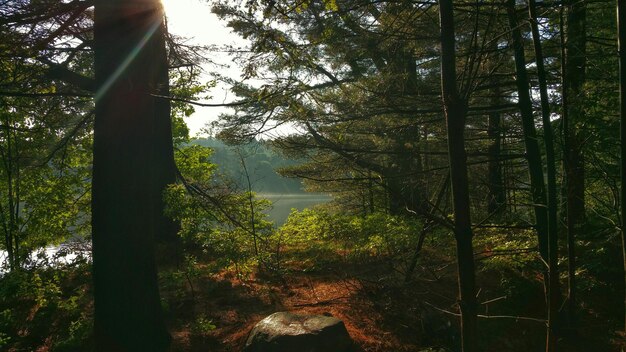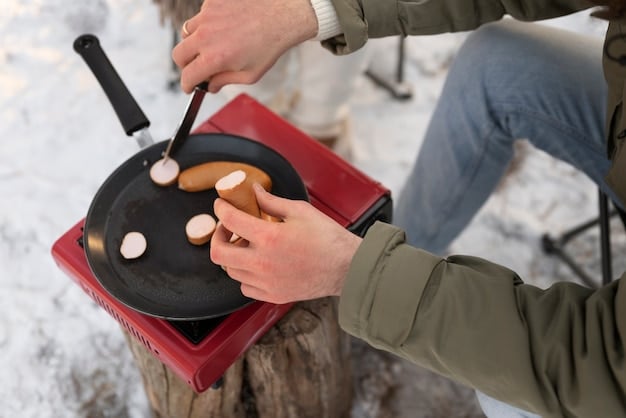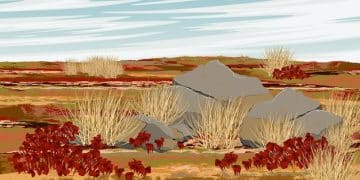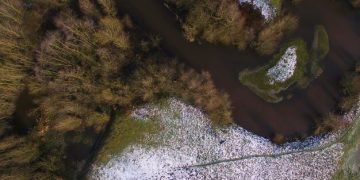Sustainable Hiking and Camping: Best Practices in US National Forests

Sustainable hiking and camping in US National Forests involve practices that minimize environmental impact, such as Leave No Trace principles, proper waste disposal, respecting wildlife, and using sustainable gear to preserve these natural areas for future generations.
Exploring the United States’ National Forests offers unparalleled opportunities to connect with nature. But, what are the best practices for sustainable hiking and camping in US National Forests? It’s our shared responsibility to ensure these pristine landscapes remain unspoiled for future adventurers. Let’s dive into how we can minimize our impact and maximize our enjoyment of these natural wonders.
Understanding Sustainable Hiking and Camping
Sustainable hiking and camping go beyond simply enjoying the outdoors; it’s about minimizing our footprint and preserving the natural environment for generations to come. It involves making conscious choices that reduce our impact on the land, water, and wildlife.
By adopting sustainable practices, we can help protect the biodiversity, ecological integrity, and scenic beauty of these precious ecosystems.
The Importance of Preserving US National Forests
US National Forests provide vital ecosystem services, including clean water, carbon sequestration, and wildlife habitat. They also offer recreational opportunities for millions of visitors each year. It’s essential we act responsibly.
- Protecting biodiversity and preventing habitat destruction.
- Minimizing soil erosion and water pollution.
- Conserving natural resources for future generations.
Ultimately, sustainable hiking and camping ensure that these forests remain healthy and resilient, capable of supporting both ecological processes and human enjoyment.

Mastering Leave No Trace Principles
The Leave No Trace principles are a cornerstone of sustainable hiking and camping. These guidelines help minimize our impact on the environment, ensuring that we leave natural areas as we found them, or even better.
By adhering to these principles, we can reduce the amount of trash, pollution, and disturbance that we leave behind.
Plan Ahead and Prepare
Proper planning is the first step towards minimizing our impact. Consider factors like weather, trail conditions, and campsite availability to ensure a safe and sustainable trip.
- Research regulations and special concerns for the area you’ll visit.
- Pack appropriately for the expected weather conditions.
- Prepare for potential hazards and emergencies.
Travel and Camp on Durable Surfaces
Stick to established trails and campsites to avoid trampling vegetation and compacting soil. Concentrating our impact on designated areas helps protect the surrounding ecosystem.
- Use established trails and campsites whenever possible.
- Avoid creating new trails or campsites.
- In pristine areas, disperse use to minimize impact.
Prioritizing established areas prevents the degradation of untouched landscapes. This strategic concentration makes a significant difference in the long-term health of the environment.
Responsible Waste Management
Proper waste management is crucial for maintaining the cleanliness and integrity of US National Forests. We must take responsibility for our trash and dispose of it correctly.
Failing to manage waste can lead to pollution, attract wildlife, and spread disease.
Pack It In, Pack It Out
Carry out everything you carry in, including food wrappers, cigarette butts, and hygiene products. Leave no trace behind, ensuring a clean campsite.
Proper Disposal of Human Waste
Dispose of human waste properly to prevent contamination of water sources. Dig a cathole at least 6-8 inches deep and 200 feet away from water sources, trails, and campsites.

Respecting Wildlife and Their Habitats
US National Forests are home to a diverse array of wildlife. It’s essential to respect their space and avoid disturbing their natural behaviors.
Reducing human-wildlife conflict can prevent harm to both animals and humans, fostering a harmonious coexistence.
Observe Wildlife from a Distance
Keep a safe distance from animals and avoid approaching, feeding, or touching them. Disturbing wildlife can stress animals and alter their natural behaviors.
Secure Food and Attractants
Store food and scented items properly to prevent attracting wildlife. Use bear-resistant canisters or hang food from trees to keep it out of reach.
- Use bear-resistant canisters in bear country.
- Hang food from trees at least 10 feet off the ground and 4 feet from the trunk.
- Never feed wildlife.
By storing food securely and observing wildlife respectfully, we minimize negative interactions and help maintain their natural behaviors.
Choosing Sustainable Camping Gear
The gear we choose can have a significant impact on the environment. Opting for sustainable alternatives can reduce our footprint and promote responsible consumption.
Selecting eco-friendly gear minimizes waste, reduces pollution, and supports companies committed to environmental stewardship.
Eco-Friendly Camping Equipment
Look for products made from recycled materials, renewable resources, or biodegradable materials. Consider products with minimal packaging and a long lifespan.
Energy-Efficient Lighting and Cooking
Use solar-powered lanterns or LED headlamps for lighting, and opt for efficient stoves that minimize fuel consumption. These choices can reduce our reliance on fossil fuels and lower greenhouse gas emissions.
Following Fire Safety Guidelines
Campfires can be a rewarding part of the camping experience, but they also pose a significant risk of wildfire. Follow fire safety guidelines to prevent unintended blazes.
Preventing wildfires protects forests, wildlife, and human communities from devastating consequences.
Check Fire Restrictions
Before lighting a fire, check for fire restrictions or bans in the area. These regulations are often put in place during dry seasons or in areas with high fire risk.
Build Fires in Designated Fire Rings
Use established fire rings or fire pits whenever possible. These structures help contain the fire and prevent it from spreading to surrounding vegetation.
- Clear a 10-foot radius around the fire ring of all flammable materials.
- Keep a shovel and water nearby to extinguish the fire.
- Never leave a fire unattended.
Supporting Conservation Efforts
Participating in conservation efforts is a great way to give back to US National Forests. Volunteer your time, donate to conservation organizations, or advocate for policies that protect these natural areas.
Collective action ensures the long-term health and sustainability of these valuable ecosystems.
Volunteering and Donations
Many organizations offer volunteer opportunities for trail maintenance, habitat restoration, and visitor education. Consider donating to organizations that support conservation efforts in US National Forests.
Advocating for Sustainable Policies
Support policies that promote sustainable management of US National Forests, such as protecting old-growth forests, reducing logging, and investing in renewable energy.
By engaging in conservation efforts and advocating for responsible policies, we can help ensure that these forests remain a vital part of our natural heritage.
The Role of Education and Awareness
Education and awareness are key to promoting sustainable hiking and camping practices. By sharing knowledge and inspiring others, we can create a culture of environmental stewardship.
A well-informed community is more likely to adopt sustainable behaviors and protect natural areas.
Sharing Best Practices
Share tips and resources about sustainable hiking and camping with friends, family, and other outdoor enthusiasts. Encourage others to adopt responsible practices.
By educating and empowering others, we foster a collective commitment to preserving the beauty and ecological integrity of US National Forests.
| Key Point | Brief Description |
|---|---|
| 👣 Leave No Trace | Minimize environmental impact by packing out all trash and staying on durable surfaces. |
| 🐻 Wildlife Respect | Observe wildlife from a distance and secure food to avoid attracting animals. |
| 🔥 Fire Safety | Follow fire restrictions and build fires in designated rings to prevent wildfires. |
| ♻️ Sustainable Gear | Choose eco-friendly camping equipment made from recycled or renewable materials. |
Frequently Asked Questions (FAQ)
The seven Leave No Trace principles are: plan ahead and prepare, travel and camp on durable surfaces, dispose of waste properly, leave what you find, minimize campfire impacts, respect wildlife, and be considerate of other visitors.
Store food in bear-resistant canisters or hang it from a tree at least 10 feet off the ground and 4 feet from the trunk. Never leave food unattended and avoid feeding wildlife, as it can alter their natural behaviors.
Dig a cathole at least 6-8 inches deep and 200 feet away from water sources, trails, and campsites. Cover and disguise the cathole after use. Pack out toilet paper and hygiene products in a plastic bag.
Use established fire rings or fire pits whenever possible. Keep fires small and under control, and never leave them unattended. Ensure the fire is completely extinguished before leaving the campsite. Check for fire restrictions before you light up.
Pack out everything you pack in. This includes food wrappers, cigarette butts, and any other trash you generate. Carry a trash bag with you and make sure to dispose of all waste properly at home or in designated receptacles.
Conclusion
By embracing these best practices for sustainable hiking and camping in US National Forests, we can collectively protect these natural treasures for future generations. Let’s continue to explore these wonders responsibly, ensuring their preservation for all to enjoy.





